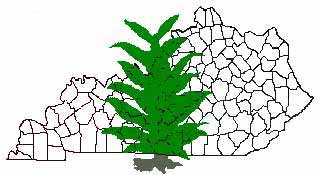
Kentucky Pest News mailings would normally switch to First Class mail at this time of the year. In compliance with a recent administrative decision prompted by postage costs, all departmental mailings with numbers of 200 or greater must be sent using Bulk Rate postage. With 1,300 subscribers, this will affect the KPN. Much of the information in this free newsletter is perishable and delays in bulk mail delivery may make recommendations or information in the articles obsolete by the time they are received.
There are two options to continue to get the
information in a timely manner. 1) Electronic
subscription The KPN is automatically sent by
email on the day it is written. If you have an
email account and would like to get the
newsletter in a timely manner, follow these
steps:
Send a message exactly as follows:
subscribe pestnews
end
Key Enter to create at least one blank line and
send
to: majordomo194@ca.uky.edu
You will be placed on the mailing list and will receive the issues by email immediately as they are posted, usually on Monday afternoons.
The Internet version usually is posted by noon on Tuesdays.
MAILING LIST UPDATE
Look for a form in the hard copy issue that must be
filled out and returned so that you will
continue to receive the KPN by mail.
Most readers who work with perennial ryegrass are aware of the emergence of gray leaf spot in the past decade as one of the most destructive turfgrass diseases known. Those of you with experience against gray leaf spot know how rapid and destructive the disease can be.
Fungicides remain our first line of defense against gray leaf spot, because all commercial varieties are susceptible and cultural practices can provide only limited control under high disease pressure. Because of the high cost of fungicides, many turf managers are interested in ways to use these important products more wisely and economically. My opinion is that at this time, there is no better way to optimize the use of fungicides than to scout your own swards for the disease and to microscopically verify the presence of the causal fungus in diseased tissues. Experienced turfgrass pathologists agree that microscopic verification is important because it is often not possible to positively identify this disease based on symptoms alone.
Proper scouting can help you decide:
The University of Kentucky Cooperative Extension Service will hold a workshop for turf managers and other interested professionals on microscopic identification of gray leaf spot of perennial ryegrass. Details are as follows:
Date & Time: June 20, 2001, from 1:00-5:00
Location: The University of Kentucky campus in Lexington
Cost: $900, Registration must be received by
Monday, May 7
While the cost may seem high at first glance, registrants
will actually be getting a lot for their money. Each
registrant will receive a high-quality compound binocular
light microscope (40-1000X magnifications, with halogen
illumination and high contrast lenses), which you will
learn to use during the workshop. In addition, each
registrant will receive dissecting kits, lense cleaning
supplies and other laboratory materials, a notebook
including color images, a 2X desk magnifier with built-in
illumination, and a field magnifying glass.
Learning Objective: As a result of this workshop, you will be able to detect Pyricularia grisea (the causal fungus of gray leaf spot) in diseased turfgrass tissue. This skill will provide the foundation for a scouting and monitoring program for gray leaf spot.
If interested in attending, please contact Pat Yancey
at
pyancey@pop.uky.edu
pyancey@pop.uky.edu for a registration form.
Registration is limited in order to provide a high-
quality learning experience for those who attend.
Interested Kentuckians should act soon, since out-
of-state registrants will be accepted on April 20.
Registration and payment must be received by
Monday, May 7.
Frankfort, KY If it sounds too good to be true, chances are, it is. That's according to officials in the Kentucky Department of Agriculture who say several vendors usually appear across the Bluegrass State about this time every year, selling ineffective chemicals at cut-rate prices.
"Each spring, we in the Department receive many complaints from home gardeners, farmers, and others who purchase cheap but ineffective chemicals over the telephone or on the Internet," said Billy Ray Smith, Commissioner of Agriculture. "The sellers of these products usually claim they're comparable to well- known national brands, and for some folks, the cheaper prices are hard to resist."
Pressure tactics are frequently used by sellers of such chemicals. "If the seller tells you to buy his product now or the deal will be gone forever, that's a strong indication that his product is no good," said John McCauley, Director of the Division of Pesticide Regulation.
The KDA's Ken Franks works with licensed pesticide retailers throughout Kentucky and says if you are considering buying a chemical product over the phone or on the Internet, you should ask the seller several questions.
--Ask for the products' EPA registration number.
--Call the KDA to ensure the product is registered for
use in Kentucky.
--Ask for the product's active ingredients and record
the percentages of each.
--Ask how many square feet or acres the product will
cover.
--Request complete directions for use of the product.
--Ask for the company's name, address, and
telephone number.
--Compare the product to a similar one offered by
your local retailer.
--Ask if the seller has a license to sell in Kentucky and
ask for his name and license number.
--Keep a record of all of this information.
"You should never buy a product that requires cash upon delivery," Franks said. "Sometimes these vendors will send you the product whether you ordered it or not, so be careful about who you talk with."
For additional information contact Ken Franks at (502) 564-7274 or
ken.franks@kyagr.com.

 We often focus on fungicides in the management of
blue mold, but cultural practices are also very
important. They help delay the onset of blue
mold, slow its progress, and increase the
tolerance of plants. We urge growers to use more
than one control method in fighting blue mold.
The following are some guidelines to aid in the
development of a blue mold control plan.
We often focus on fungicides in the management of
blue mold, but cultural practices are also very
important. They help delay the onset of blue
mold, slow its progress, and increase the
tolerance of plants. We urge growers to use more
than one control method in fighting blue mold.
The following are some guidelines to aid in the
development of a blue mold control plan.
Have a Plan: Select a blue mold management plan BEFORE you transplant that involves both Cultural Practices and Fungicides! Focus on making the environment less favorable for the pathogen to survive and infect your tobacco, making the plant more tolerant, and preventive use of fungicides rather than rescue.
Transplants: Use blue mold-free transplants. Keep the pathogen out of your community for as long as possible. The surest way to have great losses from blue mold on your farm and in your community is to set blue mold infested transplants.
Field Selection: avoid shady, wet-natured locations with poor air drainage, for example: sites near streams. Realize that if such sites must be used, more attention should be given to most of the other points listed here.
Variety Selection: Appreciate that varieties differ in their tolerance to blue mold. Consider a variety with tolerance to blue mold when planting on highly conducive sites. Be aware that current varieties with reported resistance to blue mold have low resistance to other diseases and low yield potential, so factors other than blue mold resistance should be considered in the decision.
Row and Plant Spacing: avoid high plant populations by using wider rows and wider plant spacing. From a blue mold control standpoint, wider row spacing is more important than wider hill spacing, once the plants are at least 18" apart in the row.
Fertilization: avoid excess N-fertilization and follow recommended fertilization schedules based on current soil tests that also consider cropping history.
Fungicide Spray Program: Pay particular attention to protecting tobacco plants when they are most vulnerable. Blue mold is especially aggressive on young tissues, but there is young tissue on the plant until after topping. The greater the percentage of the tissue being young, the greater the risk. Therefore, use regular protectant fungicide sprays of Acrobat MZ, as per the label, until plants are 18" tall (from bud to ground), and then activate the induced-resistance mechanism with two applications of Actigard 50W, as per the label, 10 days apart. This combination should provide a high level of blue mold control until about 14 days after the second Actigard treatment, which will be topping time for early varieties. On medium to late varieties, additional foliar fungicide sprays with Acrobat MZ will be required some season.
Topping and Sucker Control: early topping and improved sucker control slow disease progress!
Harvest: Manage the crop to get to harvest quickly, but not prematurely. Don't cut fields early to avoid blue mold losses. Remember that in healthy crops, you gain 200 lb/acre/week after topping, but in some instances, it may be advisable to destroy or early-harvest part or all of a field with blue mold to reduce the threat to nearby tobacco! Post-harvest field management: Blue mold builds up rapidly on sucker regrowth after harvest, so prevent sucker regrowth. Reduce the disease potential to later crops, by disking deeply to kill the root systems, then seed the cover crop.
Kentucky Blue Mold Warning System: Maintain contact with the Kentucky Blue Mold Warning System.
For current blue mold status, check the KY Blue Mold Warning System.
![]() http://www.uky.edu/Agriculture/kpn/kyblue/kyblue.htm
http://www.uky.edu/Agriculture/kpn/kyblue/kyblue.htm
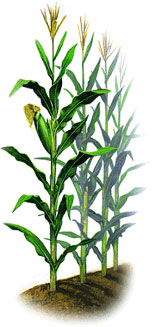
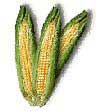 There was been some discussion this winter in
regional and statewide meetings regarding whether
or not Bt corn has value for farmers. In all
fairness this question arose outside of
Kentucky, but was mentioned at some of our
meetings. The question at hand is, averaged over
years, does Bt corn show value to producers? My
answer to that is "yes and no". It really
depends on how Bt corn is used on the
farm. Bt corn in itself does not increase corn
yields, it only protects against yield loss from
certain insect pests. In particular, protection
from injury by southwestern corn borer and
European corn borer. In the absence of attack by
these insects, no there is little value to
farmers and it is an added expense.
There was been some discussion this winter in
regional and statewide meetings regarding whether
or not Bt corn has value for farmers. In all
fairness this question arose outside of
Kentucky, but was mentioned at some of our
meetings. The question at hand is, averaged over
years, does Bt corn show value to producers? My
answer to that is "yes and no". It really
depends on how Bt corn is used on the
farm. Bt corn in itself does not increase corn
yields, it only protects against yield loss from
certain insect pests. In particular, protection
from injury by southwestern corn borer and
European corn borer. In the absence of attack by
these insects, no there is little value to
farmers and it is an added expense.
In Kentucky, we can sustain economic yield loss from southwestern and European corn borer but not in all situations and not in each location in the Commonwealth. So, how do we identify locations where we are more likely to have these problems? In the past, based on historical observation, we knew that there was a slightly increased risk of European corn borer first generation attack to early planted corn. Early planting meant that it was early planted relative to much of the corn in the area and early enough that the natural protection due to DIMBOA has declined by the onset of first generation ECB attack. Late planted corn was more likely to be attacked by second generation, and harvest losses due to this generation could be high in some years. However, European corn borer populations vary in size from year to year, and typically one or two years out of five could be considered 'bad' years.
Now, we must consider southwestern corn borer. Since 1992, this pest has been spreading eastward and northward in the state. In 2000, it was found as far east as the counties just east of the Central/ Eastern timeline running through the state. Significant yield loss has been associated with SWCB when farmers have been in late harvest situation.
In 1999 and 2000, a planting date study was conducted at the UKREC in Princeton, KY to study the value of Bt corn when planted at different times. In each year, 5 different planting dates were used for a commercial Bt corn hybrid and its commercial non-Bt isoline. At harvest the stalk injury by ECB and SWCB was measured through stalk splitting.


This study illustrated with the stalk injury data, that the risk exposure to SWCB and ECB increased with planting dates after May 1. Southwestern corn borer may be a significant yield consideration with corn planted after May 10. With corn planted in June, the risk of injury to SWCB is high. Bt corn should be a consideration when farmers find themselves in a late planting situation. But Bt corn is not the only management option. In fact with white corn producers, its not an option. Producers should also consider insecticide rescue treatments based on IPM guidelines (see ENTFACT 108) and early harvest of infested fields to limit harvest losses.
To answer the initial question, does Bt corn have on-farm value in Kentucky, yes it does when used in some situations. The best fit for Bt corn will be in late planting situations in the western half of the state. Are there situations where Bt corn should not be used? Yes! In particular where the market is calling for non-biotech corn, such as the white corn market. In addition, with early and normal planting dates, the value of Bt corn is reduced and in some situation may be less than the added cost for the seed.
![]() Frequently, we at the SCN Laboratory receive
comments from agricultural extension agents,
farmers and consultants, following submission of
soil samples for SCN testing, that certain
fields have much higher levels of SCN than
anticipated. Usually this concern is for fields
that have been out of soybean production for a
few years.
Frequently, we at the SCN Laboratory receive
comments from agricultural extension agents,
farmers and consultants, following submission of
soil samples for SCN testing, that certain
fields have much higher levels of SCN than
anticipated. Usually this concern is for fields
that have been out of soybean production for a
few years.
The question that is usually asked is "how could SCN levels be this high?" The first part of the answer to this question is to understand the reproductive potential of SCN on a susceptible variety. The table below indicates the extent to which SCN populations can increase in a field during a single growing season.
These data, which are from a multi-year study we conducted in Christian County, are typical of the extent of SCN increase on a susceptible variety in Kentucky. Note, that in all years except 1996, the SCN populations present at the time of planting were below the established threshold of 500 eggs/100 cc soil. Yield data associated with the SCN data in the table will be presented next week in Kentucky Pest News; that discussion is beyond the scope of the current article.
As can be seen from the above table, it is not unusual to get a many-fold increase in SCN populations on a susceptible variety in a single growing season. So, the first point is to be aware of how rapidly SCN populations can increase in a field. The next factor to consider is how populations react to subsequent crops. If the next crop is corn or some other SCN non-host, the SCN population will decrease by 50-80% depending upon the year.
Let's put some math to the 1998 data from the above table as an example. If the final population after growing Essex was 17,070 eggs, the population at end of the corn season will be 3414 - 8535 eggs, depending on the growing season (i.e., 50% vs, 80% reduction). Now, if another corn crop were grown, the levels could be as low as 683 if there were two consecutive years of 80% population reduction or as high as 4268 eggs if there were two consecutive years of 50% reduction....both starting at the original 17,070 eggs after Essex. Using the same logic, the low would be 137 eggs and the high 2134 eggs after the third year of corn and 27 eggs or 1067 eggs after the fourth year. The numbers would eventually drop to a base line of 2-50 eggs which represents the nematodes that are in a state of long-term dormancy. These nematodes are why you can never eliminate SCN from a field.
| Christian County Data |
|||||
| Variety | Year | At Planting Population (Pi)** | At Harvest Population (Pf) | +/- Change | Pf/Pi# |
| Essex* | 1996 | 1,926 | 12,102 | +10,176 | 6.28 |
| Essex | 1997 | 375 | 5,648 | +5,270 | 15.06 |
| Essex | 1998 | 463 | 17,070 | +16,607 | 36.86 |
| Essex | 1999 | 146 | 5,115 | +4,969 | 35.03 |
The above example shows how populations would drop as consecutive corn crops were grown (not that I would recommend such a practice). The point is that it takes at least three years out of a susceptible crop to get SCN levels below the threshold of 500 eggs/100 cc (ca. =BD cup) soil. But if things do not go your way and 50% rather than 80% annual population reductions are the case, then even after four years in corn, the SCN levels would still be above threshold. Of course many "in between" situations are also possible and, in fact, are likely. By that I mean one year the SCN populations may be reduced by 50% and the next year by 80 %, or somewhere in between these extremes.
In practice, most farmers would use a corn/SCN resistant soybean rotation rather than plant multiple years of corn. Unlike SCN non-host crops, which are fairly predictable as to their impact on SCN population declines, the impact of resistant varieties on SCN levels is much more variable. No reduction, to perhaps 25 % reduction in SCN levels are typical when SCN-resistant varieties are planted. Sometimes the reduction is greater and sometimes there is actually a net population gain. The take home point of this is that corn would represent the best case scenario as far as population reductions go. If you throw a resistant variety into the mix of the above example, then even more years may be required to get SCN below threshold. This is why we ALWAYS recommend a SCN soil test be conducted before planting a susceptible soybean. Having said the above, it is my experience that the four-year crop sequence recommended by the University of Kentucky (corn - resistant soybean - corn - susceptible soybean) typically works very well and allows farmers to effectively manage SCN and maintain high soybean yields. The focus of this article is mainly on the outlying situations.
After reading this, you may be perplexed as to why one would even want to plant a SCN-susceptible variety if SCN is in a field. The answer to this question will be the basis of an article in next week's Kentucky Pest News. Suffice it to say for now, that it is in your best interest to plant a susceptible soybean, when safe to do so, as part of an overall SCN management program. Most Kentucky soybean farmers do not follow this recommendation, probably because it is counter-intuitive and in opposition to most other disease management recommendations. However, next week I will show you data and discuss why occasionally planting a SCN-susceptible variety is invaluable in Kentucky (and mid-south) SCN management programs.
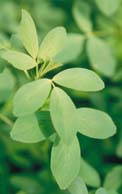
Degreeday accumulations can be used to predict
the activity of some insects, such as the
alfalfa weevil. The first signs of tip feeding
by this insect can show up in established fields
by the time 190 degreedays (base 48º F) have
accumulated since Jan 1. This damage will
result from feeding by eggs laid in alfalfa
stems last fall or during the past winter.
Predicted dates on which the first signs of
feeding can be expected at specific locations
are:
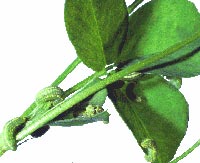
| Location | Date |
|---|---|
| Princeton | April 2 |
| Bowling Green | April 6 |
| Henderson | April 7 |
| Lexington | April 17 |
| Covington | April 19 |
Damage will not necessarily appear on these dates. The winter has been cold enough to suppress egg-laying activity so most of the eggs should be laid this spring with damage appearing a few weeks later. However, it does remind us that the weevil season is on the way.
See Insect Recommendations for more alfalfa pest recommendations.
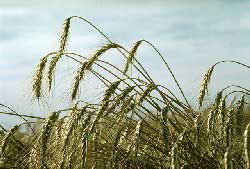
 Henbit and (Lamium amplexicaule) purple
deadnettle (Lamium purpureum) are the purple
flowered cool-season broadleaf weeds that
commonly occur in fields this time of season.
Their square stems and opposite leaves are
common characteristics of plants in the mint
family. Henbit often begins blooming in
February, while purple deadnettle may not bloom
until later. Henbit's upper leaves have no
petioles, while its lower leaves are on
petioles. Purple deadnettle's leaves have
petioles and tend to be reflexed or pointed down.
Henbit and (Lamium amplexicaule) purple
deadnettle (Lamium purpureum) are the purple
flowered cool-season broadleaf weeds that
commonly occur in fields this time of season.
Their square stems and opposite leaves are
common characteristics of plants in the mint
family. Henbit often begins blooming in
February, while purple deadnettle may not bloom
until later. Henbit's upper leaves have no
petioles, while its lower leaves are on
petioles. Purple deadnettle's leaves have
petioles and tend to be reflexed or pointed down.
Both species often coexist; however, purple deadnettle appears to occur more frequently than henbit. Purple deadnettle may be a little more winter hardy than henbit. Slight differences in susceptibility to herbicides may also explain why deadnettle is the more dominant of the two species. Early ratings of some of this year's herbicide studies indicate about 5 to 10 percent better control of henbit compared with that of purple deadnettle. This trend seemed to occur with many herbicides including Gramoxone Extra, Roundup UltraMAX, Touchdown IQ, and Harmony Extra.
Fire blight review. Kentucky apple growers are familiar with fire blight disease. This highly contagious and deadly disease attacks blossoms, leaves, shoots, branches, fruits, and roots. The disease usually first enters the tree in spring through flowers during bloom (primary infection). Primary infection occurs when bacterial populations on the surface of the tree build up during warm spring weather and when rain showers wash the bacteria on the flowers into the nectary at the base of the flower. Following primary infection, fire blight becomes established in the tree and quickly invades through the current season's growth into older growth. Death of infected branches is so rapid that the leaves do not have time to fall off the tree. Young non-bearing and newly bearing trees can easily be killed by the infection while mature bearing trees may survive even if much of the new growth is killed. Heavy rainstorms, especially those with hail in spring and early summer, can spread blight, sometimes creating injuries for fire blight entry into the tree and cause what is known as "trauma" blight.
Managing fire blight. If growers are still pruning their orchard, be sure that all of last year's fire blight strikes are pruned out and the cut branches removed from the orchard. Fixed copper sprays for suppressing buildup of bacterial populations in the trees should already have been applied to apple orchards. During bloom, antibiotic sprays are applied to control fire blight. Some Kentucky growers use a computer program called Maryblyt to track disease development and to time antibiotic applications. This computer program appears to work well under most Kentucky orchard conditions. The advantage of using Maryblyt is that growers can determine when primary infections are occurring or likely to occur.
Kentucky apple crops are now only a few weeks away from full bloom, the time for primary infections of fire blight. Growers who plan to use Maryblyt for fire blight management will want to begin collecting data to enter into the computer program now. The computer program only works if maximum/minimum temperatures, rainfall, and tree growth stage are known. Although the data can simply be written down at first, at least by pink, it is essential that all the data from green tip onwards be entered into the computer. Streptomycin, the most commonly used antibiotic for fire blight control, works well if used immediately before infection or within about 12 hours (24 hours maximum) after an infection.
Fire blight can still cause disaster. Last year, apple growers in southwest Michigan suffered tens of millions of dollars in losses due to fire blight. A combination of factors led to the fire blight disaster including:
Blight severity in these Michigan counties was such that most apple growers who planted new trees in the last five years will lose those trees. There is also concern about the health of the older orchards. All apple growers will lose a portion of their crop for the next several years due to this fire blight epidemic.
Can we reduce the threat of fire blight in Kentucky? In Southwestern Michigan it took an unusual combination of events to all come together for this most devastating epidemic to occur. Nevertheless, Kentucky growers can learn from this disaster and take actions now that will reduce fire blight.
TICKS ACTIVE NOW By Lee Townsend Ticks are active now and it will become increasingly easier to pick them up while working in or walking through or near overgrown areas. Ticks wait on vegetation and are picked up by humans and passing animals.
Here are some tips to reduce encounters with these bloodsucking arthropods.
DEET Repellents
Use just enough to cover exposed skin or clothing
(do not apply to skin covered by clothing)
Do not be spray directly on the face; spray on hands first, then rub on face Do not apply to hands of small children Do not be use on irritated skin or skin damaged by cuts or rashes Do not apply repellents in enclosed areas indoors Apply every 4-8 hours, more frequent use is not necessary
Permethrin-based repellents
Do not apply to skin! Apply only to outside of clothing before wearing - and do not saturate clothing Do not treat clothing more than once every 2 weeks Hang all treated clothing outdoors to dry for at least 4 hours before wearing Wash treated clothing at least once before treating again
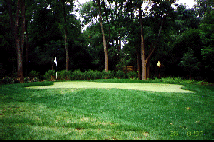
 Symptoms of what appears to be very early cases
of necrotic ring spot have been seen in Kentucky
bluegrass swards in central Kentucky, and may be
occurring elsewhere. Annual bluegrass and fine
fescues are also reported to be frequently
attacked.
The disease appears as circular to irregular
patches of dead turf up to 1-1.5 feet in size,
sometimes with green tufts of grass or weeds in
the center. Be sure not to confuse the disease
with "dog patch" (injury from dog urine). "Dog
patch" typically is surrounded by a zone of
darker green grass; it never has the green tuft
of healthy grass in the middle; and the dead
grass often has a light yellow color instead of
the tan color typical of necrotic ring spot.
The disease occurs over a wide range of soil pH
(5.0-8.0), which is different from similar turf
diseases like summer patch. Necrotic ring spot
is generally more severe in swards under stress
(low mowing height, moisture extremes).
Symptoms of what appears to be very early cases
of necrotic ring spot have been seen in Kentucky
bluegrass swards in central Kentucky, and may be
occurring elsewhere. Annual bluegrass and fine
fescues are also reported to be frequently
attacked.
The disease appears as circular to irregular
patches of dead turf up to 1-1.5 feet in size,
sometimes with green tufts of grass or weeds in
the center. Be sure not to confuse the disease
with "dog patch" (injury from dog urine). "Dog
patch" typically is surrounded by a zone of
darker green grass; it never has the green tuft
of healthy grass in the middle; and the dead
grass often has a light yellow color instead of
the tan color typical of necrotic ring spot.
The disease occurs over a wide range of soil pH
(5.0-8.0), which is different from similar turf
diseases like summer patch. Necrotic ring spot
is generally more severe in swards under stress
(low mowing height, moisture extremes).
Management suggestions include controlling thatch buildup and avoiding high nitrogen fertility, particularly in spring and summer. Once an outbreak has occurred, frequent irrigation to prevent drought stress is important to promote recovery. Controlling patch diseases with fungicides may not always provide satisfactory results. Best results with fungicides are obtained if the turf is treated preventively to protect the roots from infection. A good guideline is to treat 4-6 weeks in advance of when symptoms usually occur. Lightly water in the application prior to drying on leaves. Best results have been obtained with Rubigan and Eagle, although Chipco 26GT, Banner MAXX, and Cleary's 3336 will also provide some control. Overseed affected areas with perennial ryegrass or renovate with resistant varieties of Kentucky bluegrass or with tall fescue. Applications of products containing chlorothalonil may enhance disease pressure.
 Eastern tent caterpillars overwinter as eggs in
masses of 150 to 400 on twigs of wild cherry,
apple,
and crabapple but may be found on hawthorn,
maple, cherry, peach, pear, and plum, as well.
These masses are covered with a shiny, black
varnish-like material and encircle branches that
are about pencil-size or smaller in diameter.
Eggs hatch about the time buds begin to open.
Eastern tent caterpillars overwinter as eggs in
masses of 150 to 400 on twigs of wild cherry,
apple,
and crabapple but may be found on hawthorn,
maple, cherry, peach, pear, and plum, as well.
These masses are covered with a shiny, black
varnish-like material and encircle branches that
are about pencil-size or smaller in diameter.
Eggs hatch about the time buds begin to open.
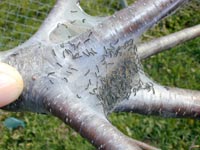 Caterpillars from one egg mass stay together and
spin a silken tent in a crotch of a tree. They
may be joined by caterpillars from other masses
to form a large colony. During the heat of the
day or rainy weather, the caterpillars remain
within the tent. They emerge to feed on leaves
in the early morning, evening, or at night when
it is not too cold.
Caterpillars from one egg mass stay together and
spin a silken tent in a crotch of a tree. They
may be joined by caterpillars from other masses
to form a large colony. During the heat of the
day or rainy weather, the caterpillars remain
within the tent. They emerge to feed on leaves
in the early morning, evening, or at night when
it is not too cold.
Defoliation of trees, building of unsightly silken nests, and later, wandering caterpillars crawling over plants, walkways, and roads cause this insect to be a nuisance in the late spring and early summer.
While tent caterpillars can nearly defoliate a tree when numerous, the tree will usually recover and put out a new flush of leaves. In the landscape, however, nests can become an eyesore, particularly when exposed by excessive defoliation.
Larvae cause considerable concern when they begin to wander to protected places to pupate. They are frequently seen crawling on other types of plants, walkways, and storage buildings. They are a nuisance and can create a mess when they are squashed on driveways, sidewalks, and patios. But keep in mind that no additional feeding or damage is done by the wandering caterpillars.
Young caterpillars feeding on leaves can be killed by applying an insecticide containing, Bacillus thuringiensis var kurstaki. Other insecticides include carbaryl, methoxychlor, and malathion. Larvae within the tents are protected beneath the webbing and are more difficult to kill with an insecticide. Insecticides are generally ineffective against mature wandering larvae.
The current southern pine beetle (SPB) outbreak has devastated pines in many areas of eastern and southeastern Kentucky during 2000 and samples of damage have been received from many parts of the Commonwealth, as well.
The stage for this outbreak was set by a number of factors, primary among them were:
This insect will attack all species of pine but prefers loblolly, shortleaf, Virginia, and pitch pine. In outbreak situations, tree species that are normally not preferred as hosts can be attacked, as well. Consequently, white pine have been hit hard, and on occasion, Colorado blue spruce has been attacked.
What are the prospects for 2001?
This winter (December 2000 - February 2001) (average temperature 33o F) has been colder than the previous four (38.4, 39.9, 40.1, and 38.3o F, respectively). However, temperatures need to be at or below 0o F, for several days to kill a significant number of developing beetles. The winter temperatures have not been low enough to have a major impact.
Simple competition among developing southern pine beetles in trees probably will have a larger effect. Beetles surviving in heavily infested trees frequently are smaller and producer fewer offspring. This can result in a decline in numbers in ensuing years. However the biggest factor simply may be a lack of suitable pines (in the proper age category) due to heavy tree mortality. Frequently, a lack of suitable hosts also contributes to bark beetle crash after an outbreak in fringe areas like Kentucky, they simply have eaten up their food. Finally, natural enemies also will begin to kill a larger proportion of SPBs than they did earlier in the cycle.
This points to a probable downturn in the SPB populations, but the damage has already been done. The population is crashing under its own staggering weight. In spite of this, there is likely to be a significant beetle flight this spring. Severely infested trees can produce as many as 150 beetles per square foot of trunk surface. That can be 15,000 beetles from a 12" diameter - 50' tall tree. Even at 99% mortality from all that can go wrong, there will be a lot of beetles flying in search of suitable hosts.
What stages of SPB are present in infested trees now?
Eggs, larvae, pupae, and adults can be found in trees during the winter. There are several generations each year so there is no real synchrony to the life cycle. The winter here has stopped flight but adults will emerge and fly once temperatures climb above 55o F. Spring attack begins about the time dogwoods flower. Newly emerged beetles can move to nearby trees or they may fly some distance before attempting to colonize a tree.
What management alternatives are available?
In some instances, heavily attacked trees have been felled and removed or destroyed. This eliminates them as a source of beetles to attack nearby pines; however, infested trees remaining in the area will produce beetles that will fly this spring.
If trees have been felled but not removed, a coarse, low pressure trunk spray of lindane, Dursban (chlorpyrifos), or Astro (permethrin) to wet the bark of the entire trunk should kill many of the beetles ready to emerge. Thetrunk will need to be turned so that the entire surface can be treated. This treatment should be applied by mid-April.
SPB attacks in home landscapes, on golf courses, and other non-forest settings have killed many valuable trees. Trunk sprays, as described above, can provide some protection from infestation / re- infestation of surviving trees. Complete coverage (crown, stem, base) is essential for protection. While SPB adults will be flying over much of the spring and summer, the spring flight is most the synchronized and is the best target for a trunk spray.
Could this outbreak have been prevented?
Climatic factors, drought and mild winter, play a major role in SPB survival and set the stage for outbreak. There was no way to manipulate this. However, forest management practices to thin pine stands for optimum growth and removal of stressed trees that are prone to SPB attack could have greatly reduced the numbers of trees at risk in some areas.
For more information on SPB, see Entfact-443, "Southern Pine Beetle".

 Termite season has begun in Kentucky. During the
next several weeks, you'll probably spend more
time responding to termite calls than to any
other household pest problem. To complicate
matters, the public has very little
understanding of termites, and what should be
done if their home is infested. This column will
help you answer their questions.
Termite season has begun in Kentucky. During the
next several weeks, you'll probably spend more
time responding to termite calls than to any
other household pest problem. To complicate
matters, the public has very little
understanding of termites, and what should be
done if their home is infested. This column will
help you answer their questions.
Q: Why be concerned about termites?
A: Termites cause billions of dollars in damage
each year. They primarily feed on wood, but may
also damage paper, books, foam board insulation,
and even swimming pool liners and filtration
systems. Termites may injure living trees and
shrubs, but usually are a secondary invader of
woody plants already in a state of decline.
While a structure may become infested at any
time, presence of termites is of particular
importance when buying or selling a home since a
termite inspection/infestation report is
normally a condition of sale. Besides the
monetary impact, thousands of winged termites
emerging inside one's home is an emotionally
trying experience in a recent attitudinal
survey, 93 percent of Kentuckians indicated
concern about the possibility of finding
termites in their home.
Q: Why are there so many termite calls during
March - May?
A: Spring is typically when large numbers of
winged termites emerge, known as "swarmers." In
nature, termites swarm in order to disperse and
start new colonies. Triggered by warmer
temperatures and rainfall, the winged termites
emerge from the colony and fly into the air. The
swarmers then drop to the ground, shed their
wings, pair off with a mate, and attempt to
begin a new colony in the soil. Very few swarmers
emerging outdoors survive to start new colonies.
Termite swarmers emerging indoors are incapable
of eating wood, seldom survive, and are best
removed with a vacuum cleaner. They do indicate
that an infestation is present.
Q: How will I know if my home is infested?
A: The presence of winged termites inside a home
almost always indicates an infestation warranting
treatment. Termites can be differentiated from
winged ants by their straight antennae, uniform
waist and wings of equal size. (Ants have elbowed
antennae, constricted waists and forewings that
are longer than the hind wings.) Swarmers
emerging from tree stumps, woodpiles, and other
outdoor locations are not necessarily cause for
concern, and do not necessarily mean that the
house, itself, is infested.
Another indication of a termite problem is pencil-wide mud foraging tubes extending over foundation walls, support piers, sill plates, etc. Termites construct these mud "shelter" tubes as they travel between their underground colonies and the structure. Termite-damaged wood is usually hollowed out along the grain, with bits of dried mud or soil lining the feeding galleries. Wood damaged by moisture or other types of insects (e.g., carpenter ants) will not have this appearance.
Oftentimes there will be no sign of the termites themselves small, creamy-white insects with an ant-like appearance. An infestation can go undetected for years, hidden behind drywall, paneling, floor coverings, insulation, and other obstructions. Termite feeding and the resultant damage can even progress undetected in wood that is exposed, because the outer surface is usually left intact. Confirmation of infestation often requires the keen eye of an experienced termite inspector. However, even the most experienced inspector can overlook damage which is hidden.
Q: Can I treat the house myself?
A: Ridding a home of termites requires special
skills. A knowledge of building construction is
needed to identify the critical areas where
termites are likely to enter. Many of these
potential points of entry are hidden and
difficult to access. Termite control also
utilizes specialized equipment such as
masonry drills, pumps, large-capacity tanks, and
soil treatment rods. A typical treatment may
involve hundreds of gallons of a liquid
pesticide, known as a termiticide, injected into
the ground alongside the foundation, beneath
concrete slabs, and within foundation walls. In
short, termite treatment is usually a job for
professionals. A possible exception would be if
a mailbox post, sandbox or other small wooden
object not attached to the house was infested.
"Do-it-yourself" termite baits (see below)
sold at retail stores will seldom eradicate an
existing termite problem.
Q: How do I choose a pest control company? Why
is there such a difference in price?
A: These are complex questions. The company
should be licensed by the Kentucky Department of
Agriculture. Membership in the Kentucky Pest
Control Association and/or National Pest
Management Association suggest the company is an
established firm with access to technical and
training information needed to do the job
correctly. As with any service company,
references are invaluable. Consider calling at
least 2-3 companies. Requesting inspections and
estimates from more than one company will
substantiate the extent of your termite problem
and allow you to compare services. Companies
offer different types of warranties or service
agreements. Most offer retreatment of localized
areas if the termites return. In some cases, no
warranty/service agreement may be offered if
construction elements such as wells, cisterns,
subslab heating ducts, drainage systems, or
inaccessible crawl spaces make it impossible to
treat in accordance with industry standards.
Take your time when selecting a company. Termites damage wood slowly; the amount of damage caused by taking an additional day, week, or month to make an informed decision is insignificant. Avoid firms that try to pressure you into signing a contract immediately with "specials" or scare tactics. Ultimately, the quality of a termite job depends less on the person who sells the job than on the individual who does the work. A safe and effective treatment requires an experienced technician, not someone who was hired a few weeks ago.
Q: Which treatment methods and products are
most effective?
A: Another complex and difficult question. There
are two general categories of termite treatment,
liquids and baits. Liquid termiticide
applications have been around for decades. Their
purpose is to provide an effective, long-lasting
chemical barrier around and beneath a structure
which termites cannot breach. Most of the
products used in recent years have been
repellent rather than lethal to termites
foraging in the soil. Two newer materials,
Premise® (imidacloprid) and Termidor (fipronil),
are non-repellent. Consequently, termites freely
tunnel into the treatment zone and are killed.
For reasons too complex to explain in this
article, it appears the non-repellent materials,
Premise and Termidor, are proving a bit more
reliable in terms of their ability to resolve
the termite problem in the first attempt.
The other broad treatment category is baits. Termite baits consist of paper, cardboard, or other "termite-friendly" food, combined with a slow-acting substance lethal to termites. Some bait materials are installed below ground out in the yard, whereas others are placed inside the structure in the vicinity of active termite tubes. Foraging termites consume the bait and share it with their nest mates, resulting in a gradual decline in termite numbers. On some properties, baits may constitute the only form of treatment; on others, they may be supplemented with either a partial or complete liquid application to the soil.
Termite baiting is a very complex subject. A detailed discussion of the considerations in having your home treated with baits versus liquids is provided in entomology extension publications, ENT-65: Termite Baits: A Guide for Homeowners, and Entfact-644: Consumer Update: Termite Baits.
Regardless of which product or approach is selected, it's important to have an experienced technician, backed by a responsible pest control firm.
Q: Does the entire house need to be treated...
or can they just "spot treat" areas where I see
termites?
A: Subterranean termite colonies may contain
hundreds of thousands of individuals foraging in
many different directions. For the pest control
company, localized or "spot" treatments are
generally a gamble, except in cases of
retreatment.
Most reputable pest control firms will not
warranty spot treatments, since it is likely
that termites will eventually find other points
of entry into the structure.
Q: How long will a treatment last?
A: All registered liquid termiticides are
supposed to control termites for at least five
years when applied according to label
directions. The actual length of control on a
given structure will depend on such factors as
thoroughness of the application, prevailing
environmental conditions, and density of
termites in the area. If termites swarm again and
continue to be a problem the year after
treatment, it's usually not from degradation of
the termiticide but because termites have found
an untreated gap in the chemical barrier.
Q: Will the termite chemical harm my family or
pets?
A: Termiticides are tested extensively for
adverse effects on health. Before a product can
be used, numerous studies are conducted by the
manufacturer and independently evaluated by the
U.S. Environmental Protection Agency. Based on
the current body of knowledge, these registered
termiticides present no significant hazard to
humans, pets or the environment when applied
according to label directions. Despite the
negligible health risk from a properly performed
termite treatment, people with lingering
concerns should consult their physician. Clients
who are still apprehensive my want to consider
having their home treated with baits.
Q: Have I been "cheated" if termites continue to
infest my house after treatment?
A: Not necessarily. Unlike other services such as
plumbing or electrical work, termite control
involves living creatures. The best treatments
performed by knowledgeable firms may fail at
times, because termites are able to find their
way through tiny, untreated gaps in the soil.
While the intent is to establish a continuous,
impenetrable chemical barrier in the soil, this
is all but impossible to achieve in actual
practice. In the case of baits, it may take
several months for termites to initially find
the installations in the soil, and several months
more to achieve control.
The key in termite control is to hire a reputable pest control firm employing experienced, conscientious technicians. Companies will usually return and retreat affected area(s) at no additional charge provided the service agreement is purchased and maintained.
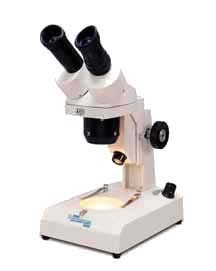
We have seen only a few samples of agronomic crops over the past week, including wheat with symptoms of stress/cold injury, and tobacco seedlings (over-head irrigated) with both Pythium root rot and Rhizoctonia damping-off. In addition to woody ornamentals showing winter injury and drying (boxwood, holly, magnolia, euonymus), we have seen samples of greenhouse ornamentals with Botrytis blight (Kalanchoe); powdery mildew (rose) and Pythium root rot (begonia, impatiens).
Lee Townsend
Extension Entomologist